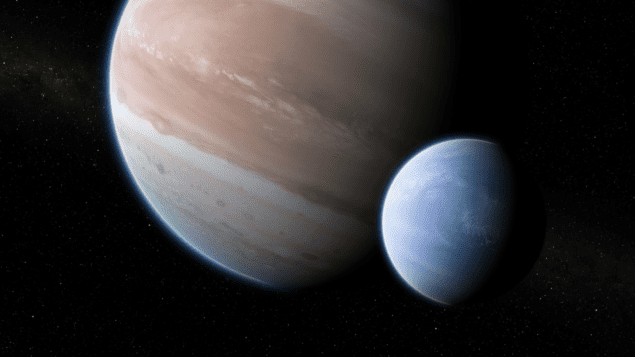
Further evidence that a giant moon the size of Neptune is orbiting a Jupiter-sized planet 4000 light-years away has been put forth by astronomers using the Hubble Space Telescope.
Hints of what could be the first known exomoon (moon outside the Solar System) first came to light in 2017, after Alex Teachey and David Kipping of Columbia University in New York found some unusual behaviour in its parent planet, Kepler-1625b. NASA’s Kepler Space Telescope discovers planets by watching for the small dip in starlight as the planet moves across the face of its parent star. These dips are periodic as the planet orbits the star, but Kepler-1625b’s transits seemed out of kilter. Sometimes the transits would occur a little earlier, or a little later, than predicted.
Such events are called transit timing variations (TTVs). They are usually seen in compact planetary systems, such as those around red dwarf stars, where the planets are very close together and are able to gravitationally tug upon one another to affect the timing. However, Kepler-1625 is a Sun-like star and there is no evidence for another nearby planet. Some other object is therefore pulling on Kepler-1625b, with Teachey and Kipping reasoning that it must be a moon. The only snag is that to impart such a large TTV, the moon must have a mass similar to Neptune.
Complex motions
Despite the exomoon’s huge size, proving its existence has been difficult. This is partly because the transits of moons are more complex than planets, says Teachey, who points out that “the moon can show up before the planetary transit, or after, but never in the same place twice, unless you observe a large number of transits”.
The planet’s wide orbit means that Kepler only saw three transits of the planet during its original four-year mission. The system appears faint in the sky so no ground-based telescopes have been able to make follow-up observations. So enter the Hubble Space Telescope.
Using Hubble for 40 h in October 2017, Teachey and Kipping were able to observe another transit of the planet with the space telescope’s greater resolution, which is four times sharper than Kepler’s. Sure enough, the planet was observed to transit 77.8 min late, but most intriguingly there was a hint of a smaller object transiting just after the main transit of the planet had ended. This secondary transit could be a exomoon.
Inclined orbit
Teachey and Kipping compared the observations to a range of various models – including some that did not include a moon – that could potentially explain the data. They found the best match to be a Neptune-sized exomoon, named Kepler-1625b i, on an inclined orbit at a distance of 35 to 45 planetary radii from Kepler-1625b.
“I’m not sure if we can call it ‘surprising’, since we have no other examples of exomoons so far, but I didn’t expect to find an inclined moon,” says Teachey. This inclination of 45° to the orbital plane of the planet is far greater than the 5.1° inclination of Earth’s Moon. It could be a hint as to the exomoon’s origin. However, given that the existence of such a large, oddball moon had not even been predicted until now, astronomers will struggle to explain how it got there.
An obvious question is: can an object with the diameter and mass of Neptune truly be classed as a moon, or is the pair a ‘double planet’? The location of the centre of mass in the system may define this, but Teachey is nonplussed about the debate.
“The mass ratio that we derive [between the moon and the planet] is only about 1.5%, so I’d call it a moon,” he says. “But I’m not too hung-up on this distinction – it’s a semantic argument as far as I’m concerned.”
Dearth of detections
Astronomers have been sifting through data from Kepler for evidence of exomoons since the planet-finding mission launched in 2009. Kepler-1625b i is the first to be claimed, but the long wait and dearth of other detections has “not surprised” Michelle Hill of the University of Southern Queensland, Australia, who earlier this year was the lead author of a paper calculating the possibility that there could be more moons in habitable zones around stars than there are planets.

Kepler space telescope could find exomoons
“I feel we are on the cusp of an era of exomoon detection and that once our instrument sensitivity improves there will be a wealth of moon detections,” says Hill. That could begin with NASA’s new Transiting Exoplanet Survey Satellite (TESS) mission, which is charged with looking at much brighter stars in the sky, and could offer better opportunities for spotting exomoons.
The observations are described in Science Advances.



